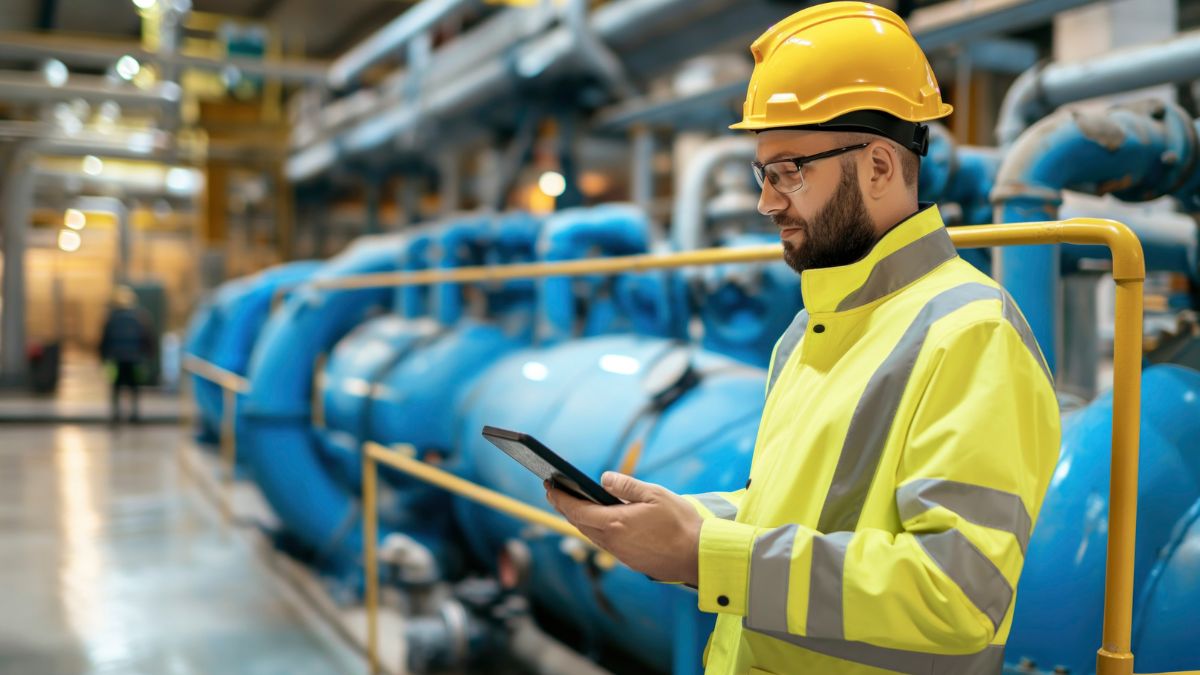TECHNOLOGY
Innovative Office Desks with Integrated Technology: The Future of Workspace Design

The modern office is evolving at a rapid pace, driven by advancements in technology and changing work habits. One of the most exciting developments in this space is the rise of office desks with integrated technology. These innovative designs are transforming work environments by enhancing productivity, improving ergonomics, and creating more interactive and adaptable workspaces. In this article, we’ll explore the future of workspace design through the lens of these cutting-edge office desks.
The Convergence of Design and Technology
Traditional office desks are functional but often lack the flexibility and innovation needed in today’s dynamic work environments. Enter the era of smart desks—workstations that seamlessly blend design and technology to meet the needs of the modern workforce. These desks are not just furniture; they are sophisticated tools that enhance the way we work.
Key Features of Technologically Integrated Desks
- Wireless Charging Capabilities: One of the most common features in these desks is wireless charging. Integrated charging pads allow users to power their smartphones, tablets, and other devices without the clutter of cables. This not only keeps the workspace tidy but also ensures that essential devices are always within reach and fully charged.
- Built-In Touchscreens: Some desks now come with embedded touchscreens that serve as digital command centers. These screens can be used for video conferencing, managing schedules, controlling smart office equipment, or even for creative tasks like sketching and note-taking. This integration minimizes the need for additional monitors or tablets, streamlining the workspace.
- Height Adjustability with Memory Settings: Ergonomics play a crucial role in office design, and height-adjustable desks are becoming a staple in modern workspaces. The latest models feature motorized adjustments with memory settings, allowing users to switch between sitting and standing positions with the push of a button. These desks can also be programmed to remind users to change positions throughout the day, promoting better posture and reducing the risk of musculoskeletal issues.
- Smart Lighting Integration: Lighting can significantly impact productivity and comfort. Desks with integrated smart lighting systems allow users to customize the lighting to suit their needs, whether it’s for focused work, relaxation, or video calls. Some advanced systems can adjust the lighting automatically based on the time of day or the user’s activity, creating an optimal work environment at all times.
- Environmental Sensors: To promote well-being and productivity, some desks are equipped with sensors that monitor environmental conditions such as air quality, temperature, and humidity. These sensors can alert users to unfavorable conditions and, in some cases, even adjust the environment automatically, such as by activating air purifiers or adjusting the desk’s ventilation.
- Integrated Cable Management: Cable clutter is a common issue in traditional workspaces. Modern desks are designed with built-in cable management systems that keep cords organized and out of sight. Some desks go a step further, offering retractable cable reels or even wireless power solutions that virtually eliminate the need for cords altogether.
The Impact on Productivity and Well-Being
The integration of technology into office desk is more than just a trend; it has tangible benefits for productivity and well-being. By reducing the friction between tasks, these desks allow workers to focus more on their work and less on managing their workspace. For instance, the ease of switching between sitting and standing can lead to less physical strain, which in turn improves concentration and energy levels throughout the day.
Moreover, the ability to customize the work environment—whether through lighting, desk height, or device integration—ensures that each user can create a workspace that suits their unique needs. This personalization is key to maintaining comfort and reducing stress, which are critical factors in both productivity and long-term health.
The Future of Workspace Design
As technology continues to advance, the line between furniture and digital tools will blur even further. We can expect future office desks to incorporate even more sophisticated technologies, such as AI-driven systems that learn user preferences and automate adjustments accordingly. Additionally, with the growing emphasis on sustainability, we may see desks made from eco-friendly materials that integrate energy-saving features like solar charging panels.
Another exciting prospect is the potential for augmented reality (AR) integration. Imagine a desk that projects virtual screens and interfaces directly onto the surface, eliminating the need for physical monitors and allowing for a more immersive and flexible workspace. These developments could revolutionize not only how we work but also how we interact with our work environments.
Conclusion
Innovative office desks with integrated technology are paving the way for the future of workspace design. By combining functionality, ergonomics, and cutting-edge technology, these desks are helping to create work environments that are more efficient, comfortable, and adaptable to the needs of today’s workforce. As this trend continues to evolve, it promises to redefine our relationship with our workspaces, making them not just places to work, but hubs of productivity and innovation.
TECHNOLOGY
Finding High-Quality Electronic Devices & Tools: Everything You Need to Know

It can be hard to keep updated with the latest technological devices as retailers constantly work to churn out newer and better products every year. From regular devices like smartphones and laptops to tools like GPS systems for your car, having the highest-quality products can put you above the rest when it comes to your business and personal needs. If you are in the market for a new electronic device, follow this guide so that you will end up with the best products available today. That is, until the next big thing emerges.
Identify Your Needs
Figuring out what you want from a product is the first thing you need to do before you start perusing your options. For example, if you need a new computer for work, you have to think about all of the tasks you will perform on it. This will set you up with a list of all of the non-negotiable features to look for. You should also think about how often you will use the product and how well it will integrate into your daily life. Once you have a good understanding of what you need, you can start looking online or go to a brick-and-mortar location to speak with a tech expert about your options.
Browse Top Retailer Websites
A great starting place is to make a list of your top technology retailers. These can be sellers of trusted products that you have used before or brands that you think have a good reputation for selling quality devices. Once you have three or four in mind, you can start browsing their websites to see the latest products they have to offer. These websites should have expert ratings of each product and detailed photos with descriptions to help you make your decision.
Read Customer Reviews
Before purchasing an expensive electronic device, it is important to get opinions from your peers on how well they work. This can be done in many ways. You can search online forums, look up reviews on third-party websites, or read reviews directly from the retailer’s website. If you want to see a lot of reviews of different brands, head to this Romanian product review website, where you can see which high-quality electronic devices rank the highest among real customers. These user reviews can help paint a better picture of each product and give examples of how they are used in real-world scenarios.
Understand Quality Indicators
Quality indicators of a product usually come from brand reputation, materials used, and certifications. For example, if you buy a product from a brand that you have used in the past and have never had issues with, then you know that a new product from the same brand will likely deliver similar results. As for materials used, this is something you may have to look for in person. Go to the nearest tech retailer so that you can hold the product in your hand. While there, you can also ask a tech expert about the materials used to construct it to see if it is made well.

When looking for a new piece of technology to add to your collection, remember that taking a bit of time to read reviews and seeing the product in person will help you make the best decision. Use these tips to walk away with a reliable electronic device that will be a welcome addition to your home or office.
TECHNOLOGY
The Role of Quality in Tank and Storage System Decisions

When it comes to selecting tanks and storage systems, whether for industrial, agricultural, or commercial use, quality is not just a desirable trait; it is a fundamental requirement. The materials used, the manufacturing standards followed, and the system’s durability can significantly influence operational efficiency, safety, and long-term cost-effectiveness. With so many options available in the market, decision-makers must prioritize quality above all else to ensure reliability and performance. This blog post explores six core aspects of how quality plays a pivotal role in tank and storage system decisions, influencing everything from structural integrity to environmental compliance.

Material Selection and Durability
One of the first and most critical aspects of quality in tanks and storage systems is the choice of materials. High-quality tanks are constructed from materials that match the intended contents, whether that’s water, chemicals, fuel, or food products, and are resistant to corrosion, UV degradation, and temperature fluctuations. For example, stainless steel is often favored in chemical and food storage due to its resilience and non-reactive properties. Polyethylene tanks with UV inhibitors are widely used for water storage in outdoor environments. Inferior materials may lower upfront costs but can lead to early degradation, leaks, or contamination, requiring costly replacements or repairs. Ensuring quality through proper material selection means investing in longevity and safety.
Structural Integrity and Engineering Standards
Ensuring the structural integrity of tanks and storage systems is crucial for safe and reliable operation. Quality tanks are designed to withstand environmental stresses, pressure changes, and everyday wear without compromising their function. Engineering standards guide these designs, setting requirements for materials, welds, and construction. For instance, proper installation of tank stands is important to support the weight and maintain the stability of above-ground tanks, preventing deformation or failure. Without adherence to these rigorous standards, tanks may be prone to leaks, cracks, or collapses, leading to costly damages or safety hazards. Following established engineering guidelines ensures that tanks perform effectively over their lifespan.
Safety and Compliance Considerations
Quality manifests in the system’s ability to meet industry safety requirements and environmental regulations. Storage tanks often hold hazardous or sensitive materials that, if leaked or mishandled, could pose severe risks to personnel and ecosystems. High-quality systems incorporate features like secondary containment, pressure relief valves, and anti-corrosion linings that prevent accidents. They come with certifications indicating compliance with OSHA, EPA, or FDA standards, depending on the application. Cutting corners with low-quality tanks jeopardizes safety and can result in heavy fines, legal liabilities, and reputational damage. Compliance is a byproduct of quality and is vital for maintaining trust and accountability.
Maintenance Efficiency and Lifecycle Costs
Another dimension of quality in tank systems is how easily and economically they can be maintained over their operational life. Well-constructed tanks require fewer frequent repairs and are easier to inspect, clean, and service. Features such as smooth interior surfaces, manways for access, and corrosion-resistant coatings contribute to efficient maintenance. While high-quality systems might have a higher initial cost, their reduced maintenance needs and longer service life make them more economical in the long run. Cheaper alternatives often accumulate costs through frequent breakdowns, unplanned downtime, and higher labor requirements. Thus, evaluating lifecycle cost is key to appreciating the full value of quality.
Customizability and System Integration
Quality includes the adaptability of tanks and storage systems to meet specific operational needs. High-quality manufacturers offer customizable options, such as specific fittings, temperature controls, insulation, and monitoring systems, that ensure seamless integration with existing processes. Customization minimizes compatibility issues and enhances system efficiency. In low-quality tanks, such flexibility is often missing or poorly implemented, resulting in retrofitting complications and inefficiencies. Selecting a quality system means you’re choosing a partner who can tailor solutions to your requirements, further supporting productivity and workflow consistency.
Reputation and Vendor Reliability
The source of your tank or storage system plays a huge role in determining its quality. Reputable manufacturers with a history of excellence are more likely to follow strict quality assurance processes, use superior materials, and provide dependable customer support. These vendors are more transparent about their product certifications and are willing to back their products with warranties and technical documentation. Choosing a supplier based solely on price can result in poor after-sales support, limited product documentation, and inadequate warranty coverage. Working with a trusted vendor ensures the quality of the product and the reliability of service, which is invaluable for long-term operations.

Quality is the cornerstone of every effective tank and storage system decision. From material strength and regulatory compliance to lifecycle cost and vendor support, each factor reinforces the idea that cutting corners in quality can have serious consequences. By prioritizing well-built, reliable systems, businesses protect their investments and enhance operational efficiency, safety, and sustainability.
TECHNOLOGY
How to Evaluate Technical Skills When Hiring Web Developers

Hiring a skilled web developer is one of the most important steps when building a strong online presence. Whether you’re launching a new website, improving an existing platform, or creating a custom web app, you need developers who not only understand your vision but also have the technical ability to bring it to life.
While resumes and interviews help, they don’t always reveal the full picture of a candidate’s technical skills. Knowing how to properly evaluate a developer’s capabilities ensures you’re hiring the right person for the job- and not just someone who can talk the talk.
This guide breaks down how to assess technical skills clearly and effectively so you can hire web developers with confidence.
Understand Your Project Requirements First
Before diving into skill evaluations, you need a clear understanding of your project’s technical needs. Are you building a front-end user interface or a full-stack web platform? Will your website require integrations with APIs, databases, or third-party tools?
Write down what you expect the developer to do. This can include:
- Designing web pages using HTML/CSS
- Coding interactivity with JavaScript
- Using frameworks like React or Vue.js
- Managing backend systems with Node.js, PHP, or Python
- Handling databases such as MySQL or MongoDB
- Deploying to cloud platforms like AWS or DigitalOcean
By defining what skills are needed, you’ll be in a better position to measure whether a candidate has what it takes.
Review Their Portfolio and Past Projects
One of the simplest and most effective ways to evaluate technical skills is by reviewing a developer’s past work.
Look for the following in their portfolio:
- Websites or apps that function smoothly
- Clean, user-friendly design
- A variety of features that demonstrate versatility
- Links that work and don’t lead to errors
- Sites optimized for mobile and different browsers
A good portfolio gives insight into the developer’s real-world experience and shows you the quality of their work. Ask for links to live sites or a GitHub repository.
Test for Core Coding Skills
While portfolios are great, they don’t always prove that a developer wrote the code. That’s where technical tests come in.
You can test for specific skills depending on the role, which includes:
- Front-End Developer Tests
- Back-End Developer Tests
- Full-Stack Developer Tests
Use platforms like HackerRank, CodeSignal, or custom in-house tests to evaluate skill levels.
Use Real-World Scenarios
A great way to evaluate technical skill is by giving candidates a task that mimics something they’d do on the job.
Real-world tasks give you a clear idea of how well a candidate can apply their skills in practical situations. They also show how they approach problem-solving, which is just as important as the final result.
Check Their GitHub or Code Repositories
Developers who are active on GitHub often share their code for others to see. This can be a valuable window into their technical style.
You don’t need to be a developer yourself to see whether their code is neat and organized. If you’re unsure, ask a technical advisor to take a look.
Assess Problem-Solving and Debugging Abilities
Technical skills go beyond writing fresh code. A good developer should also be skilled at debugging and fixing errors.
Watch how they handle roadblocks. Do they stay calm? Do they know where to look? Can they explain their thought process? These are key indicators of a strong developer.
Consider Their Comfort With Tools and Frameworks
Most modern development jobs require the use of certain tools. A good web developer should be familiar with:
- Code editors like VS Code or Sublime
- Version control systems like Git
- Frameworks such as React, Angular, or Vue.js
- CSS preprocessors like SASS or LESS
- Project management tools like Trello or Jira
When evaluating candidates, ask them to describe the tools they use daily and how comfortable they are with each. Their answers can give insight into how fast they’ll adapt to your workflows.
Include Soft Skill Evaluation in Technical Interviews
While this article focuses on technical skills, don’t forget that communication, teamwork, and responsibility are just as important.
During the technical interview, observe how well the candidate can:
- Explain their code or choices
- Listen and ask questions
- Accept feedback or suggest improvements
- Work through a coding challenge calmly and confidently
A skilled developer who communicates clearly will be easier to work with in the long run.
Use Hiring Platforms That Pre-Screen Talent
If evaluating technical skills feels overwhelming, you can use trusted platforms that pre-vet developers for you. Sites like FreeUp, Toptal, and Upwork allow you to hire from a pool of tested professionals.
With Freeup pricing, for example, you’re not only getting skilled developers but also transparent rates and flexible hiring options. You can hire for hourly, part-time, or full-time roles based on your budget and needs. The platform pre-screens freelancers, saving you time on the early stages of technical evaluation.
Don’t Skip Reference Checks
Once you’ve found someone who seems technically sound, always check references. Ask past clients or employers:
- What type of work did the developer do
- How well they met deadlines
- Whether they handled technical challenges efficiently
- How they worked within a team or with project managers
Even a quick email or phone call can confirm whether your top pick is as good in practice as it appears on paper.
Be Clear About Your Expectations
Even the best developer may struggle if expectations aren’t clear from the start. Before making a final offer:
- Define the scope of the job
- Share timelines and delivery goals
- Agree on tools and communication methods
- Make sure they’re comfortable with your tech stack
This sets both sides up for a smoother working relationship and fewer misunderstandings.
Keep Your Hiring Process Consistent
Consistency is key when evaluating multiple candidates. Stick to the same tests, interview format, and review process for each applicant. This ensures fairness and helps you make smarter comparisons.
Document your process for future hires so your team always knows how to evaluate technical skills effectively.
Hire With Confidence
Hiring a skilled web developer doesn’t have to be stressful. By focusing on clear project needs, evaluating real-world skills, and using structured assessments, you can identify candidates who truly match your goals.
Use portfolios, live coding tasks, and problem-solving challenges to dig deeper than a resume. And if you’re short on time or unsure where to start, platforms with transparent systems can give you access to pre-vetted professionals quickly.
Interested in learning more? Browse our other blog posts to gain insights into a range of topics.

 Cartoon1 year ago
Cartoon1 year agoUnlocking the Potential of Nekopoi.care: A Comprehensive Guide

 Game1 year ago
Game1 year agoExploring Aopickleballthietke.com: Your Ultimate Pickleball Destination

 BUSINESS1 year ago
BUSINESS1 year agoWhat Companies Are In The Consumer Services Field

 BUSINESS1 year ago
BUSINESS1 year agoUnraveling the Mystery of 405 Howard Street San Francisco charge on Credit Card

 HOME IMPROVEMENT1 year ago
HOME IMPROVEMENT1 year agoVtrahe vs. Other Platforms: Which One Reigns Supreme?

 TECHNOLOGY1 year ago
TECHNOLOGY1 year agoThe Guide to Using Anon Vault for Secure Data Storage

 ENTERTAINMENT11 months ago
ENTERTAINMENT11 months agoUnderstanding Bunkr Album: A Comprehensive Guide

 ENTERTAINMENT1 year ago
ENTERTAINMENT1 year agoThe Epic Return: Revenge of the Iron-Blooded Sword Hound
















